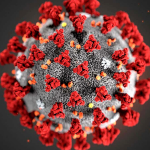“Hysterical” Chest Spasm
Suspected Conversion Disorder Treated by Homeopathy
IAN SPOHN, ND
Conversion disorder is a conventional psychiatric diagnosis, a rare example where Western medicine acknowledges the mind-body link. Also known as functional neurological symptom disorder, conversion disorder essentially refers to sensory and/or motor symptoms with no pathological basis, not fitting the pattern of any known neurological disease, but still significant enough to impact the patient’s ability to function. The key to recognizing conversion disorder, and the reason it is considered a psychiatric diagnosis, is that the symptoms are generally precipitated by a significant psychological stressor or emotional trauma.
Conversion disorder is diagnosed more commonly in female patients, though it also has a predilection to affect combat veterans, the majority of whom are male. Estimates place the female-to-male ratio anywhere between 2:1 and 10:1 depending on the population studied,1 and it is useful to note that long before the third edition of the Diagnostic and Statistical Manual of Mental Disorders (DSM-3) conceptualized the term, the phenomenon now called conversion disorder was formerly known as hysteria.2 While theories etiologically involving the uterus have long since been discarded, severe functional disorders brought on by emotions have been acknowledged, treated, and indeed cured for quite some time, especially in homeopathy.
The old rubric Mind, Hysteria from Kent’s Repertory lists over a hundred remedies, spanning from the obscure such as Ferrum phosphoricum to classic hysterical remedies such as Ignatia, Hyoscyamus, Moschus, and Tarentula hispanica. Ignatia is a well-known polychrest remedy that will cover many spasmodic conditions due to grief, while Hyoscyamus can be considered if there is a strong element of jealousy to the case, and especially if the patient evinces the famously lascivious desire to undress. Moschus should be thought of for hysterical asthma triggered by fits of rage, the classic keynote being “the patient scolds until blue in the face.” Tarentula hispanica can be indicated when there is a cunningly manipulative nature to the patient and may therefore be useful in disorders like Munchausen syndrome. There are, of course, dozens of other remedies found under Mind, Hysteria, and while these clinical rubrics are a useful starting point for studying comparative materia medica, the correct remedy must of course be sought and prescribed on the totality of the patient’s unique symptoms. Sometimes the most strikingly unusual symptoms are not related by the patient herself, but we are able to observe them about the patient, as the following case will relate.
A Censorious Patient
On a quiet morning when I had no patients to see, I received a call from a woman who sounded very desperate and distraught, wanting to know if I could possibly see her immediately. She was most apologetic over the phone, and positively effusive with relief and gratitude when I told her it just so happened that I could see her at once. Shortly afterwards she arrived, a graceful 51-year-old female patient dressed all in black, with a very elegant black lace bow in her hair. I must admit I was looking forward to being profusely thanked again for so promptly accommodating her, but upon entering my office the first thing she did was very rudely criticize everything about it. She hated the decorations; it didn’t look at all like a doctor’s office; this wasn’t anything like what she was expecting. She actually had the nerve to ask how I dare see patients in here! I was quite taken aback at her vehemence, but as I am also a homeopath, I quietly wrote down Mind, Censorious and proceeded to take her case.
Her chief complaint was constant shortness of breath with an inability to properly expand her chest, accompanied by continual soreness localized to the intercostal muscles. She was married to a man she never loved who had abused her physically and emotionally for 32 years. They were currently separated but not divorced for religious reasons. She reported feeling safe in her present situation. Her current symptoms began 3 ½ years previous after changing her place of residence and unpacking some old belongings that reminded her of the abuse. She reported symptoms of both depression and anxiety, with panic attacks characterized by a paralyzed heaviness of the chest. These panic attacks would occur 1-2 dozen times per day. She also reported intense fatigue, claiming she was “a real go-getter who should have the energy to move the world,” but rating her energy level as a 0 out of 10. This interfered with her many commitments, which included running her own fire and water restoration business, raising her 5 children alone, and heading a volunteer committee at her church. Additional questioning revealed the following symptoms: constant weeping throughout the day, bouts of nausea improved by eating, tension of the trapezius muscles relieved by massage, and a constant sensation of a lump in the throat.
Based on the clearly emotional elements of the case, the sensations of pain and paralysis described, and the presence of concomitant symptoms such as globus hystericus, I suspected the patient did not have asthma or any pulmonary disorder, but instead a conversion disorder affecting her intercostal muscles, whereby her emotional state was causing spasms and paralysis through some functional neurological mechanism. Because conversion disorder is considered a diagnosis of exclusion, in addition to being generally poorly understood, the diagnostic workup is extensive. In this case, it may have involved a full neurological and psychological examination, pulmonary function testing to rule out asthma, an electroencephalogram to rule out possible seizure activity, imaging studies to rule out brain lesions and multiple sclerosis, and perhaps an anti-acetylcholine receptor antibody test to rule out myasthenia gravis.
The Power of Ignatia
Before proceeding to further workup however, I decided first to try classical homeopathic treatment, because to me this elegant, intensely depressed patient seemed a perfect case of Ignatia. I did not actually repertorize the case, but instead based my choice of remedy on the following formal and informal rubrics:
- Mind, Hysteria (referring to physical symptoms with an emotional cause).
- Changeable, erratic mood: relieved and grateful one moment, harshly critical the next.
- Rude, censorious, easily disappointed: she said, “This is not at all what I was expecting!”
- Mind, Audacity: describes herself as a real go-getter, takes on many responsibilities, dares to insult a doctor who was kind enough to see her immediately.
- Ailments from grief, abuse, and disappointed romance.
- Spasmodic complaints: paralyzed sensation in intercostals, tension in trapezius muscles.
- Paradoxical modalities: in this case, nausea strangely relieved by eating.
- The keynote symptom: globus hystericus.
Ignatia did cover her chief complaint. Hering’s Guiding Symptoms gives “spasmodic constriction of chest” and “impeded respiration, like from a weight on chest” as verified cured symptoms of Ignatia3; however, I only learned this after the fact, as this patient honestly had me too flustered to properly work up her case. I felt as if I were walking on eggshells with her the entire consultation, and her utter, brazen contempt upon entering my office was so striking to me that it called to my mind precisely the following passage from Kent’s lectures on Ignatia: “You cannot depend upon her being reasonable or rational. It is best to say as little as possible about anything. Make no promises, listen, look wise, take up your traveling bag and go home after you have prescribed, because anything you say will be distorted. There is not anything you can say that will please.”4
Rather than attempting to work up the case and give a lengthy explanation to this patient of what homeopathic prescribing typically demands, I decided to take Kent’s advice and simply give the patient a single dose of Ignatia 200C in the office, with instructions to follow up with me in 2 days. She seemed predictably dissatisfied with the capful of pellets I handed to her, but within 3 seconds of taking them she smiled with a look of pleasant surprise, as if she could hardly believe what was happening, and told me it suddenly felt she could take a deep breath for the first time in 3 ½ years. After 2 days, she called to report that the night after taking the remedy she had a dream where she met her dead father, and since then, both her anxiety and depression were “hundreds of times better.” She reported some mild lingering soreness and tightness in her chest, but the initial improvement had held, and she was having no trouble breathing. She was so grateful for the improvement that she had me treat her children and mother as well, and at no point was she ever again even the slightest bit rude to me.
REFERENCES
- Peeling JL, Muzio MR. Conversion Disorder. [Updated 2021 May 19]. In: StatPearls [Internet]. Treasure Island (FL): StatPearls Publishing; 2022 Jan. Available from: https://www.ncbi.nlm.nih.gov/books/NBK551567/
- Owens C, Dein S. Conversion disorder: the modern hysteria. Advances in Psychiatric Treatment. 2006;12(2):152-157.
- Hering C. The Guiding Symptoms of Our Materia Medica. New Delhi, India: B. Jain Publishers (P) Ltd.; 2010.
- Kent JT. Lectures on Homoeopathic Materia Medica: Together with Kent’s New Remedies Incorporated and Arranged in One Alphabetical Order. Delhi, India: B. Jain Publishers; 2004.

Ian Spohn, ND, graduated from NCNM in 2016 with a doctorate in naturopathic medicine and an additional certificate in homeopathy. He has worked as a classical homeopath in private practice in Colorado Springs, Colorado, and currently works as a product design specialist for Grato Holdings, Inc. in Woodbine, Iowa. In addition to the study of alchemy, Dr Spohn is passionate about current regulatory issues facing homeopathy, and is a proponent of the dietary work of Weston A. Price.









